‘A cup of tea with your cave, madam?’: cave tourism as a cottage industry at Mole Creek, Tasmania 1894–28
Honorary Associate, University of Tasmania
Email: lakelea22@yahoo.com.au
Abstract
From the late 1800s, farmers at Mole Creek in Tasmania conducted nature tourism from their homes. Families such as the Parsonses, Scotts, Martins and Byards offered cave tourism experiences as a cottage industry, otherwise engaging in farming and in some cases hunting and other forms of work. While not operated by a Mole Creek farmer, King Solomons Cave was a similar example of family-based private cave entrepreneurship. King Solomons, Marakoopa, Baldocks and Scotts Caves offered rustic, idiosyncratic experiences with home-style hospitality. All four caves were lit by acetylene gas. Ultimately, the family cave trade was unsustainable. The government’s purchase of King Solomons and Marakoopa in 1920 and 1921 respectively and the introduction of the electric light gradually brought the era to a close.
Introduction
A recent television news report about the restoration of a hunter’s hut on Tasmania’s Borradaile Plains highlighted the inequity of heritage listing in the state. While dozens of 19th-Century Tasmanian sandstone mansions are heritage listed (two are World Heritage listed for their convict connections), the mostly wooden structures representative of the lives of yeoman farmers and highland industries have been neglected by an under-funded, architect-dominated Heritage Tasmania. Hopefully that organisation’s current examination of the Meander Valley Municipality, which contains cave tourism sites such as the Chudleigh Inn, the Mole Creek Guest House, the Mole Creek Hotel and farms in the Mole Creek district, will give it the chance to partly address this.
Until recent times, rural Tasmania was a divided society. In simple terms, wool-growers, effectively the landed gentry, owned the fertile central plains, and yeoman dairy farmers the island’s rural extremities. In 1918 the Midlands and south-east had two-thirds of the state’s sheep, while the north-west and north-east owned two-thirds of its dairy cattle.1 Each industry had its own lobby group, the TFSOA (Tasmanian Farmers, Stockowners and Orchardists Association) for the Midlands and south-east woolgrowers, the Tasmanian Producers’ Association (later the TFF, Tasmanian Farmers Federation) for the dairy farmers of the north-west and north-east. Until the 1960s it was almost a case of never the twain shall meet.
This division reflected different land settlement policies. In the period 1824–31 most of the best grazing land on the island was granted to large-scale growers of fine wool for the European market.2 From the 1850s, however, when Tasmania’s population was being depleted by the Victorian and New South Wales gold rushes, the Tasmanian government opened bush blocks (the so-called ‘waste lands’) beyond the Midlands plains on liberal terms in order to encourage selection and develop a stronger economy.
From late in the 19th Century, the typical regime for a dairy farmer on bush blocks at Smithton, Winnaleah or Mole Creek might be growing potatoes, oats and peas for human consumption, rye corn or mangolds to feed the cattle, and keeping pigs which lived on the skim milk residue from the dairy. Many backblocks farmers supplemented—or even multiplied—their incomes by hunting for furs in winter, repairing roads, clearing other bush blocks or doing other labouring work. In 1923, for example, when the average wage of a farm labourer was from about £110 to £120 per year, Anderson ‘Jack’ Scott of Scotts Cave made £240 from wallaby, pademelon and possum furs during one three-month hunting season.3
The advent of nature-based tourism at Mole Creek
As branch railways radiated into the backblocks, some of the more enterprising bush farmers also took advantage of their frontier location to provide nature tourism experiences for urban excursionists. In the inner north, proprietors of the Chudleigh Inn had provided an early model for nature-based tourism in the Mole Creek district by guiding visitors through nearby Wet Cave as early as 1851.4
From the 1880s there were regular experiments in nature-based tourism in Tasmania. Diego Bernacchi failed in an attempt to sell his Grand Hotel sanatorium on Maria Island to inter-colonial and international tourists.5 By the 1890s even the remote West Coast offered nature-based experiences such as Gordon River and Macquarie Harbour cruises. Accounts of recreational treks to Cradle Mountain, in the northern highlands, appeared in newspapers by 1888, and five years later John Wat Tyler examined the potential of the Forth River Gorge, Cradle Mountain, Mounts Roland, Pelion and Black Bluff for tourism.6 Tyler also operated summer tours from Hobart to Russell Falls, Bruny Island, Maria Island and Eaglehawk Neck, as well as a tour from Launceston to the Flowery Gully Caves near Beaconsfield.7
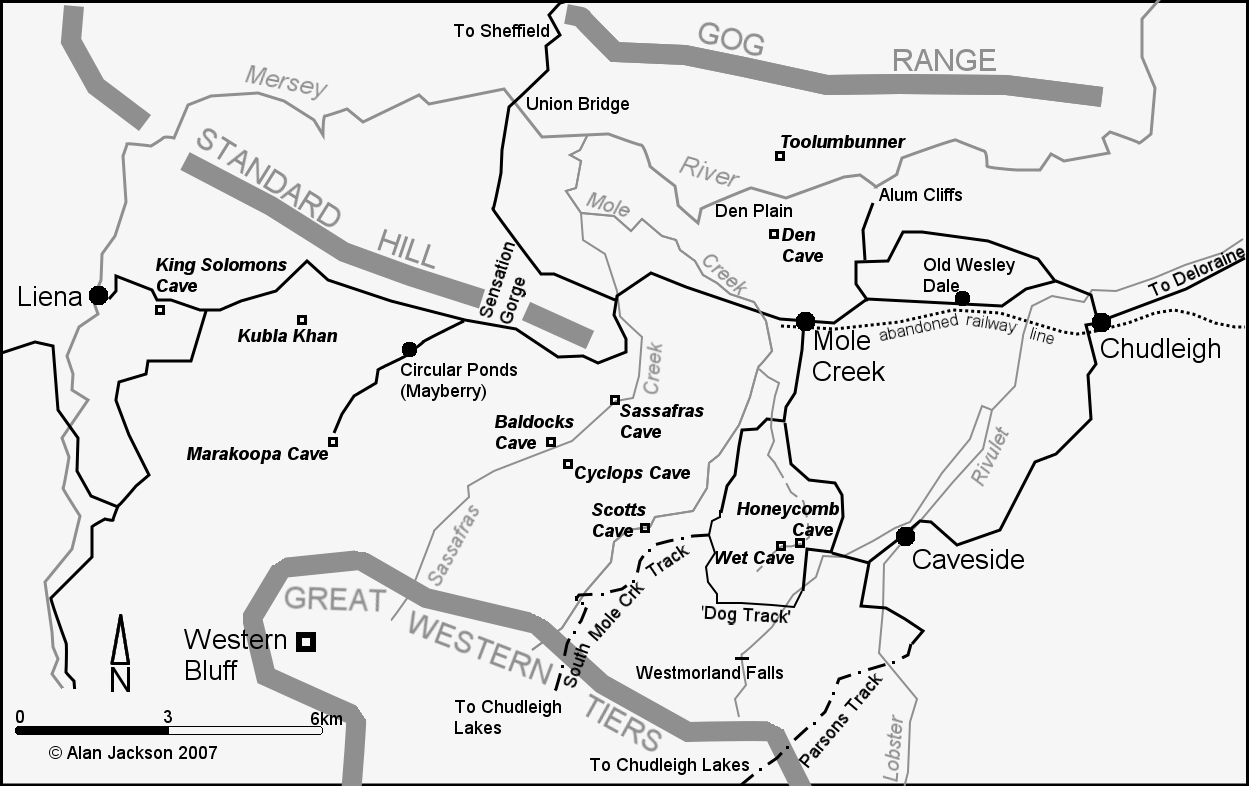
Mole Creek district caves known by 1920: map by Alan Jackson
Examples of nature tourism as a cottage industry, that is, carried out in or from the home, were rare. In the early 1890s, at the Henty River on the West Coast, Theophilus Jones and his family turned an old ferry house and farm into a nature tourism resort near the Strahan-Zeehan Railway.8 Similarly, the advent of railway excursions on the Mole Creek line from 1894 enabled Joseph (JR) and Phil Parsons and their brothers at Caveside to guide tourists through Wet Cave and along their own track to Westmorland Falls.9 They not only conveyed visitors from railway station to cave, but began the tradition of providing refreshments which became a staple of Tasmanian cave tourism. Dairy farms, of course, were never short of fresh milk, cream, cheese, butter or, usually, ham, bacon, eggs and vegetables.
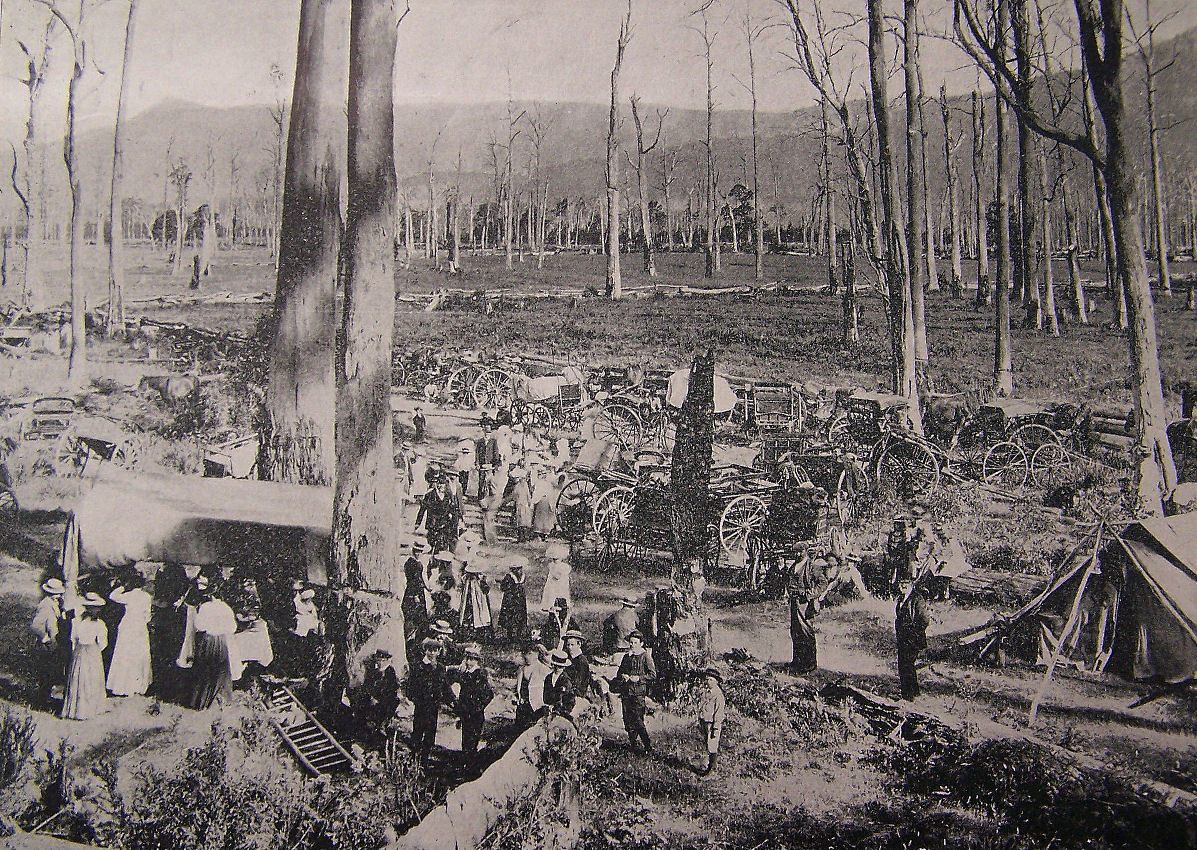
Traps, tents and even a ladder at base camp during a Railway Department excursion to Wet Cave in 1902. Stephen Spurling III photo
This was only one facet of the Parsons brothers’ tourism enterprise. Working in tandem with the Northern Tasmanian Fisheries Association, they increased the traffic through Caveside by stocking the Chudleigh Lakes on the Great Western Tiers with fish. The Parsons track, Parsons Falls and Parsons hut, features of the brothers’ hunting regime, now also featured in accounts of hiking and fishing expeditions which they guided on the Great Western Tiers.10 Phil Parsons declared the Devils Gullet lookout the ‘Yosemite Valley of Tasmania’, but the Chudleigh Lakes fishing resort was scuttled by the advent of the famous Shannon Rise near Great Lake after 1911.11

Like the Jones family at Henty River on Tasmania’s West Coast during the 1890s (centre), and Gustav and Kate Weindorfer at Waldheim Chalet near Cradle Mountain from 1912 to 1932 (right), the Scotts (left) exploited a particular natural asset, their cave, but also offered other nature-based recreations, farm-style accommodation and home-grown food. Scotts advert from a 1908 tourist guide; Henty Ferryhouse advert from Mercury newspaper 3 March 1891, p.3; Waldheim advert from Tasmania’s Alps brochure, circa 1914.12
The advance to entrepreneurship: Scotts Cave
In 1907 the Scott family took the Parsons regime a step further after the discovery of Scotts Cave on their land at South Mole Creek. While the Parsonses made money from their own labour and their own track infrastructure, the Scotts, dairy and potato farmers, spent money to make money. Equipping their cave with acetylene light and applying fantastical names to its features, George Scott and family added private cave tourism, accommodation and guiding to a family work regime of farming and hunting.13 (While acetylene blackened caves, it was a step up from the equally damaging candles and bark torches, at a time when electricity was not a lighting option.) A four-room Scotts guest-house accommodated those who wanted to see more of the district that had produced such limestone marvels (on one evening there were 32 guests, some in tents and others sleeping on straw in the barn).14 This anticipated highland tourist regimes like Paddy Hartnett’s centred on Pelion Plain and the upper Mersey River and Gustav and Kate Weindorfer’s Waldheim Chalet business at Cradle Valley.15

(Left) The four-room Scotts guest-house stands to the left of the ‘Roslyn Lea’ farmhouse at South Mole Creek. Scotts Cave is in the gully behind the farm. (Right) George Scott crossing the apple orchard with acetylene reflector in hand, bound for the cave. Scotts’ apples were a culinary highlight for visitors. Photos courtesy of Jim Scott
Just as Gustav Weindorfer became famous for his badger (wombat) stews, the Scotts’ goose dinners, apple pie and scones rated highly. The family’s general hospitality prompted much banter:
Six precious souls from Westbury Arrived here yesterday; Two came upon the bicycle, Three drawn by Harry’s bay. They saw the Alexander’s [Scotts] Caves And thought them very fine; They stayed the night at Mr Scott’s And drank up all the wine. They ate up everything he had, Sang songs both high and low, They kept the household out of bed And filled their souls with woe.16
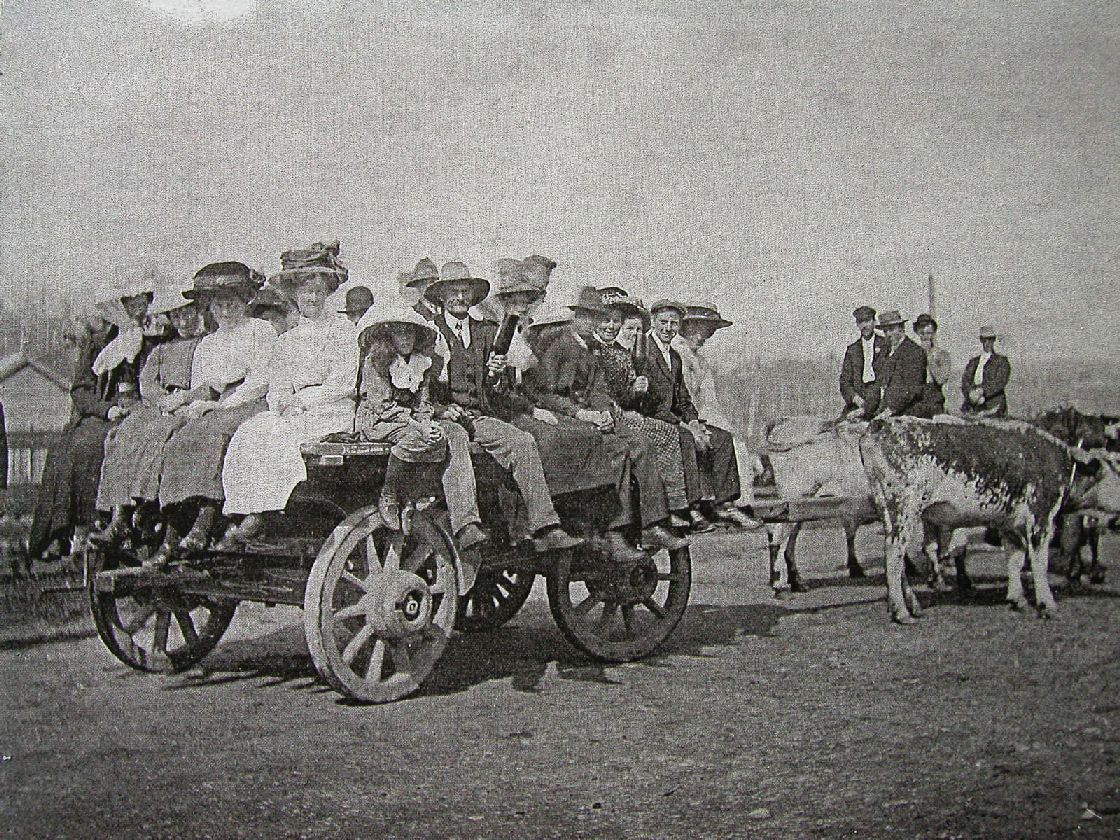
By bullock team to ‘fairyland’… excursionists in Sunday best armed with bottles of plonk headed for Scotts Cave. Courtesy of Denise Hilton
References to drinking and adolescent romance, plus the composition of verse, suggest that the intimacy of the small cave made visiting Scotts Cave more of a social experience than visiting the rival Marakoopa Cave:
What have become of the girls we kissed? What of the challenging lips we knew? Ah! Let me whisper it - the’re [sic] not missed Half as bitterly those we kissed As those we didn’t, but wanted to!!!!!17
The weekend outing must have been a release for many ‘townies’. There were no wowsers in this underworld:
These stalactite caves make a deep impression on a thinking mind. In the dark recesses you may easy [sic] imagine there are little gnomes hidden. It seemed to me they were offering me goblets of wine and [lager], for they knew I was thirsty, as it was very warm in the upper world...18
The cave was also child friendly. The Scotts Cave underworld contained other sparkling fairy ‘receptacles’ and ‘dishes’, later known as ‘The Waterlilies’. The ‘Kings Palace’ seemed to be
made for the king of gnomes to hold his court, and has a bower opening out of it fit for his queen, though Titania, queen of fairies herself, need not disdain it.19
In 1913 the Scotts hosted the American Presbyterian evangelist John Wilbur Chapman, during his worldwide ‘revival’ tour. Jack Scott recalled how, as a 17-year-old, he and Lindsay Howe guided a Chapman party into the mountains:
We were to get a prize for the first one to shoot a kangaroo. None of us shot any the first day, but the next day Dr Norton came around and he said, ‘Dr Chapman wants to see you two boys around at the front!’ Lindsay and I went around and he gave us a sovereign apiece. We thought we were made.20
Scotts’ boarding house lasted only until 1915. It was then sledged by bullock team a short distance from ‘Roslyn Lea’ to replace Mick Scott’s house, which had been destroyed by a bushfire.21 Growing and improving competition, aging parents and scattering offspring sapped the Scott family business.22 The dawn of the electric light at a rival cave in 1928 cast Scotts Cave into eternal shadow.
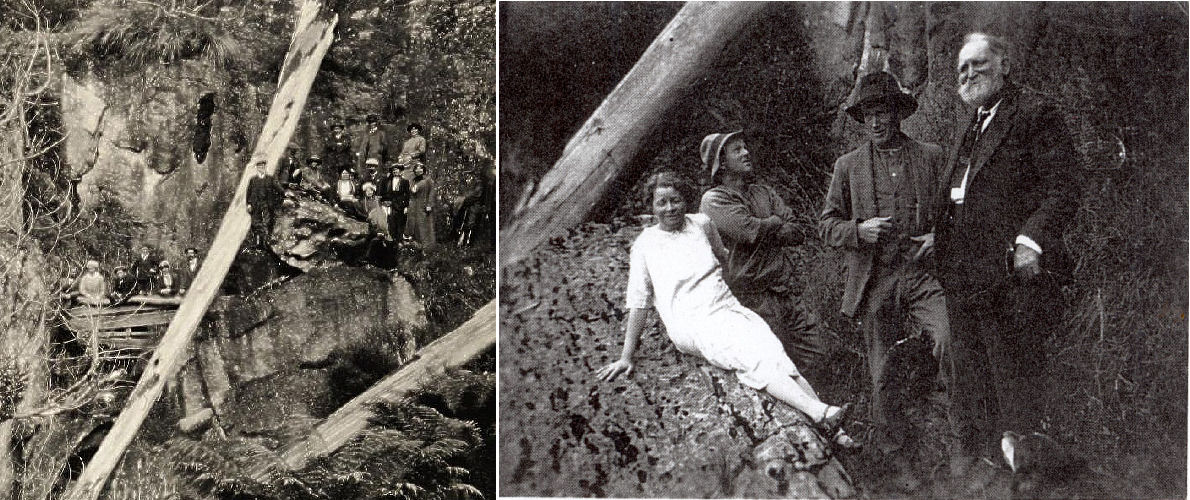
(Left and right) The financial limitations of private cave tourism conducted by bush farmers is apparent in these images of Scotts Cave visitors packed onto a rickety cliff-face balcony and a precarious rock perch between fallen logs. Twenty-one people await a tour in the left-hand photo, taken in 1917. Left photo cropped from one by JW Beattie; right photo courtesy of Jim Scott.

Stephen Spurling III backlit this image of the ‘Frozen Waterfall’ in Scotts Cave. Visitors to the cave would have seen a less glamorous formation by acetylene jet. Stephen Spurling III photo courtesy of Stephen Hiller
Dazed and convinced: selling King Solomons Cave
King Solomons Cave was the next private cave venture in the Mole Creek district to be developed with acetylene light. It was never a farming family affair—but an entire family suffered for it. Edward Charles (EC) James, the cave developer with what his grandson Bill James calls the ‘soup-strainer’ moustache, was full of bluster. ‘I claim and can prove that I with my own money and brains have done more for tourists and mining in Tasmania than any other man or men,’ James justified his unsuccessful application to mine the Cradle Mountain Reserve in 1942.23
King Solomons tourists saw the input of his money, in the form of stairways, galleries and an acetylene plant with 40 lights, which were in place in time for the cave’s official opening in 1908. EC James’ family did not see much money, his wife Elizabeth having to grow vegetables in the back yard to sell to support their family and his entrepreneurship.24 Nor for many years did King Solomons’ discoverer WH Pochin see the exchange of money which gave James the right to call himself the cave’s lessee.25 It took the Supreme Court to make James pay up, a deal which was only finalised when the government bought James’ lease from him in 1920.26
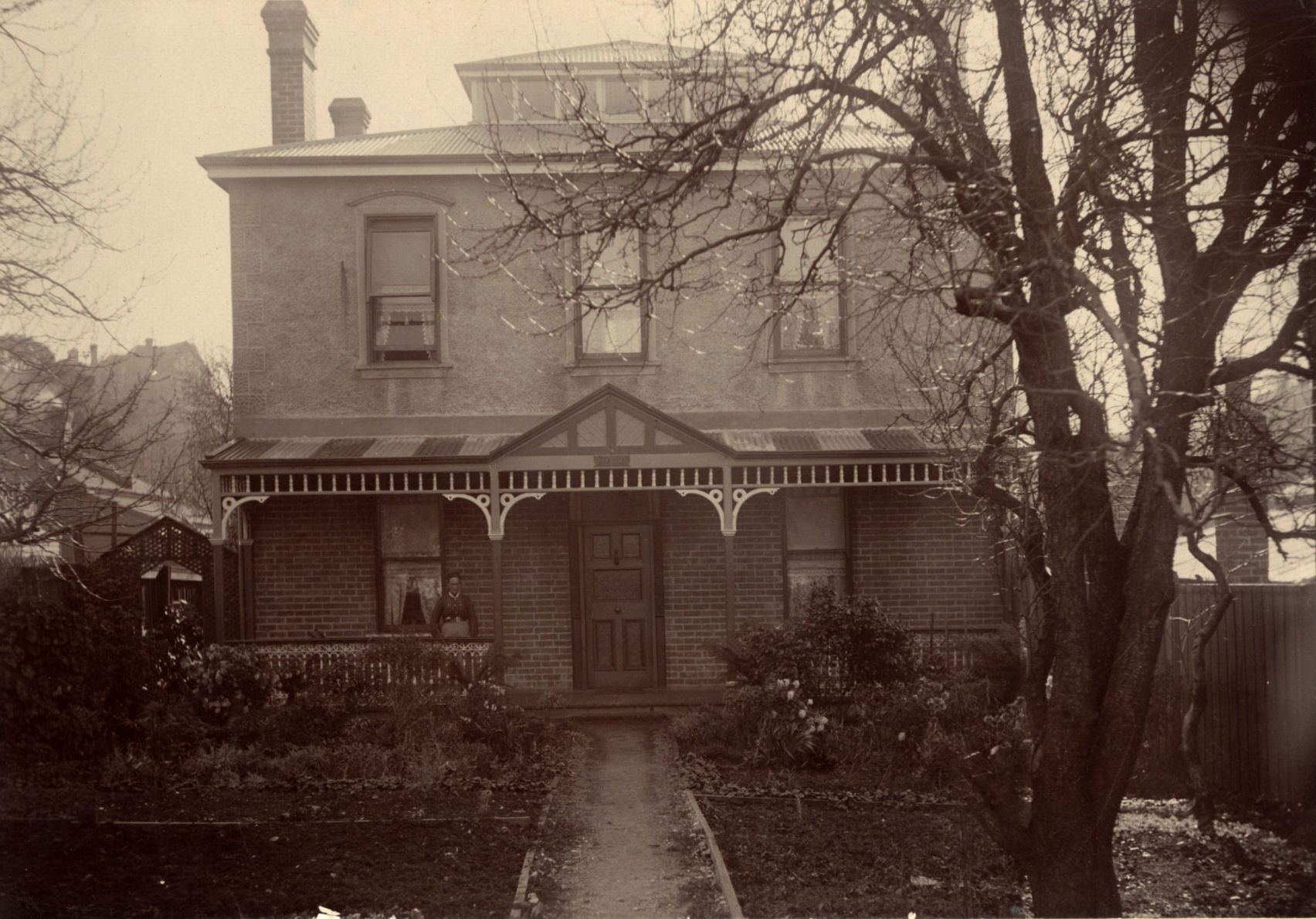
EC James surveyed his realm from this glass lookout at ‘Fernleigh’, Sandy Bay, Hobart. A vegetable garden behind this grand fašade helped sustain his family while he played at cave and mining entrepreneur. Courtesy of Bill James.
The former Dover shopkeeper was a born showman who invited patrons to ‘be convinced, mystified and dazed’.27 He named not only King Solomons Cave but all its features, including the three columns ‘Faith, Hope and Charity’ after the Christian saints.28 With qualified backing from Jenolan Caves superintendent Voss Wiburd, James declared his cave the finest in Australia.29 So keen was James’ bluster about King Solomons that he sponsored a lawn bowling trophy in its honour, personally conducted the first Government Tourist Bureau excursion to Mole Creek, and even featured lantern slides of the main cave and nearby Queen of Sheba Cave in his Queenborough (southern Hobart) Council electioneering.30 James claimed there were six separate caves on the 15-acre King Solomons lease:
- King Solomons
- Queen of Sheba
- James Wyburd [sic] Cave
- Mammoth Cave
- Jacksons Cave
- Badger Cave
He claimed that there was also an unexplored ‘Underground Lake’.31 Some of these features have never been seen since.
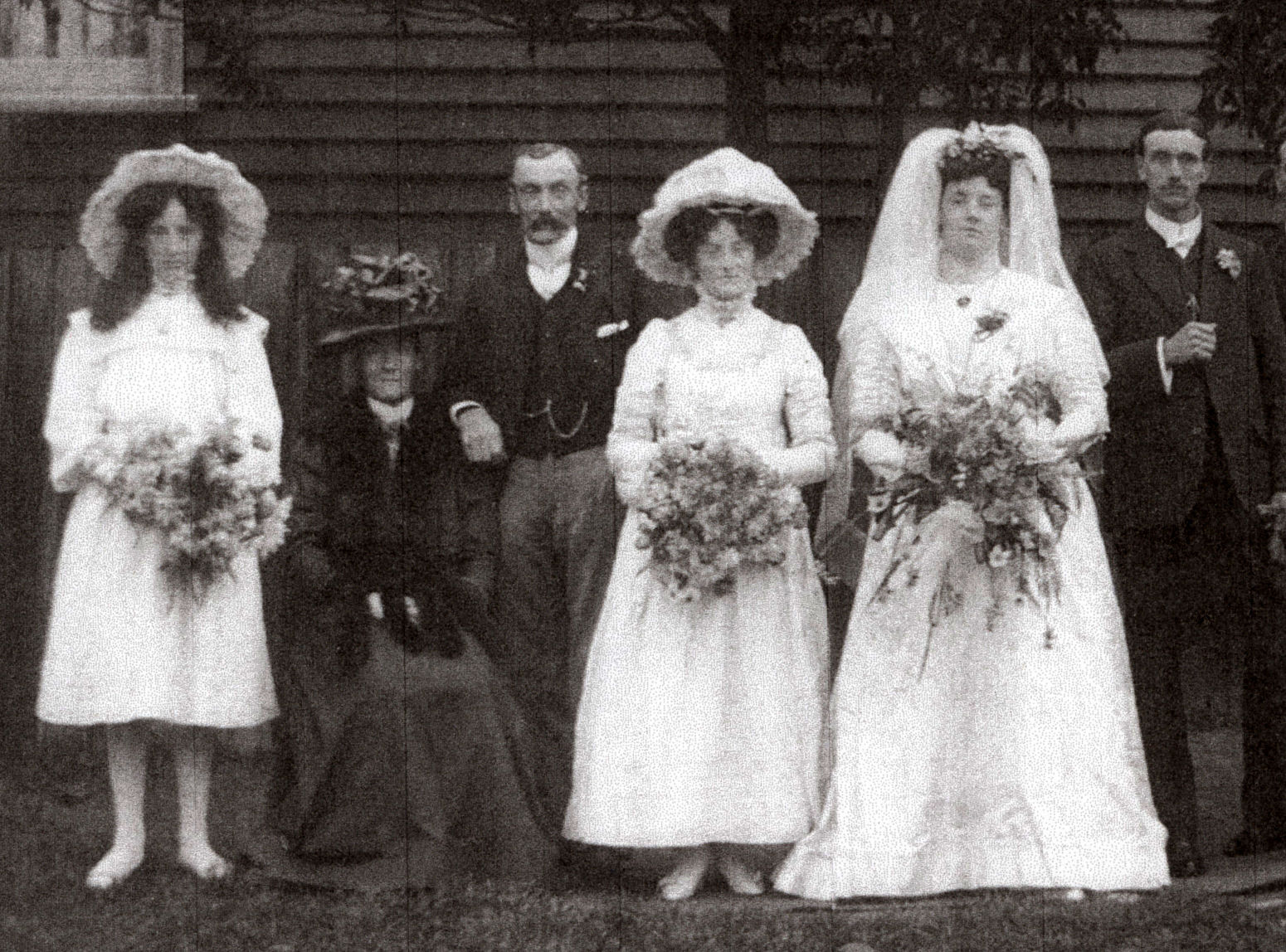
Keeping it in the family: every person in this cropped James family wedding photo had a King Solomons Cave connection. (Left to right) daughter Nellie James (‘Little Nellies Grotto’ was named after her), wife Elizabeth James (‘Mums Bower’), the cave’s promoter EC James, daughter Minette James (‘Minnies Bower’), daughter and bride Linda James (‘Lindas Bower’) and groom and King Solomons cave guide Bert Langley. EC’s son Fred James (not pictured) also guided at King Solomons. Courtesy of Bill James
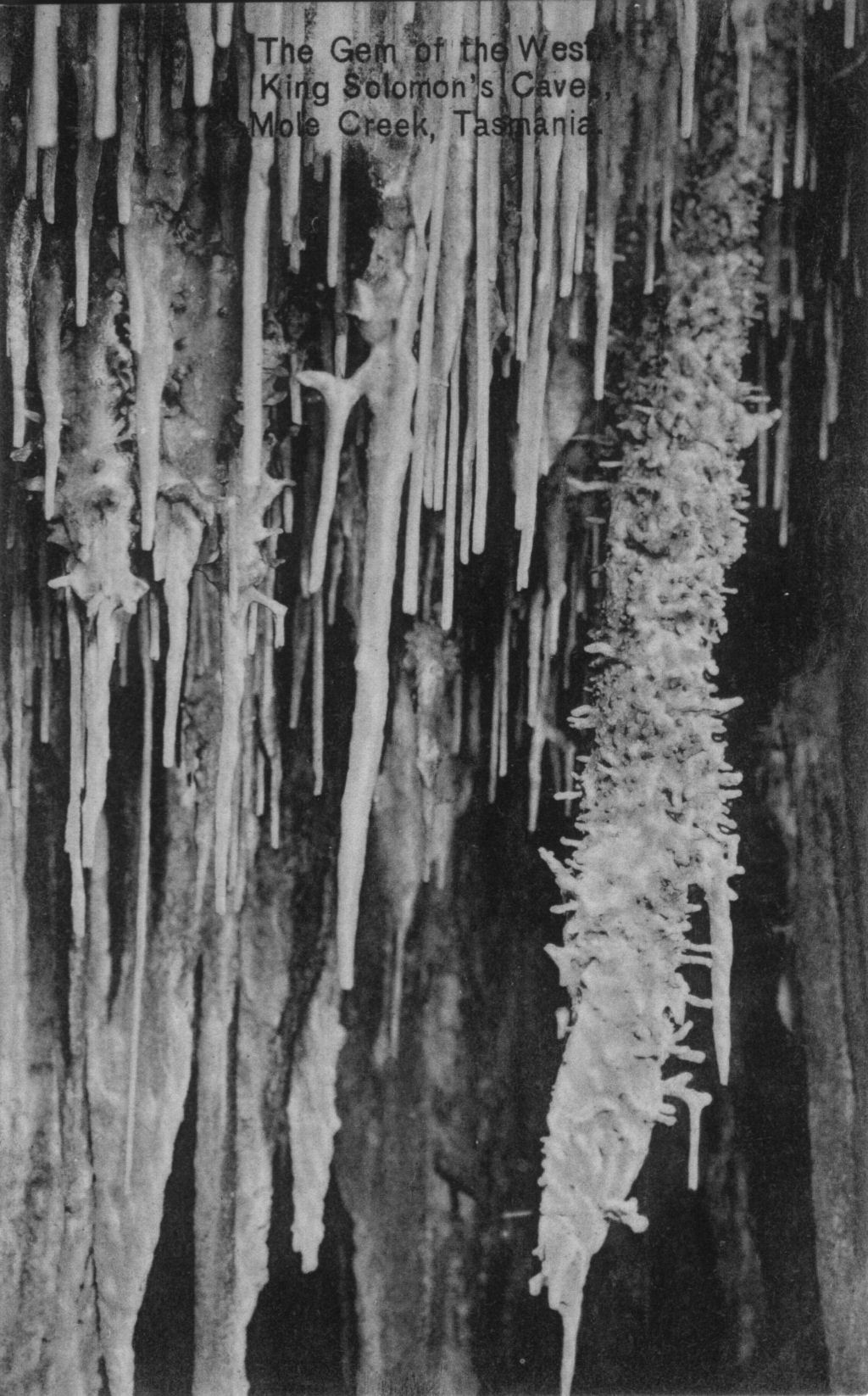
For EC James, postcards were a propaganda weapon, a King Solomons calling card that he still dispensed in 1928, eight years after he handed over the cave to the government. The ‘Gem of the West’ helictite in the unlit Queen of Sheba Cave, however, remained unseen by visitors. Stephen Spurling III postcard courtesy of Mike Simco

An invoice from Mountain View House for the government’s 1916 Easter trip to Mole Creek shows that the family-friendly Scotts Cave (32 visitors) was then more popular than the more beautiful King Solomons (22), Marakoopa (22) and Baldocks (28) Caves. Advert courtesy of Denise Hilton; invoice courtesy of Bill James.
More substantial was the tea room which James built at the cave, although the original plan was for something stronger. A legend exists that James’ proposal for a Mole Creek hotel was defeated by a temperance clause in the fine print of a property deed, but the truth is more prosaic.32 James bought a block of land opposite the Mole Creek railway station from the estate of Henry Reed at an auction in December 1908.33 At that time the nearest pub was at Deloraine, 23 kilometres away, the licence on Dan Pickett’s Chudleigh Inn having been allowed to lapse since his death in 1899. The local licensing board met to consider applications in November each year, but in April 1909 it received a lone application from Dan’s son, Walter Pickett, to grant him a new licence for the Chudleigh Inn.34 Pickett had probably got wind of the proposed Mole Creek Hotel only seven kilometres from his establishment and decided to get in first. James either met with local resistance to a second hotel licence in the district or decided that a second licence would not pay.
As Mountain View House, James’ pub with no beer remained unlicensed until 1953. James kept it in the extended family by selling to his son’s in-laws, George and Alice Lee, who operated it as an accommodation house from which they conducted tours to all the caves and local attractions. James maintained a fatherly watch over King Solomons right up until its official reopening with electric light in 1928, during which visit he stopped off at the Mole Creek State School to ‘convince, mystify and daze’ small children with postcards of ‘his’ cave.35
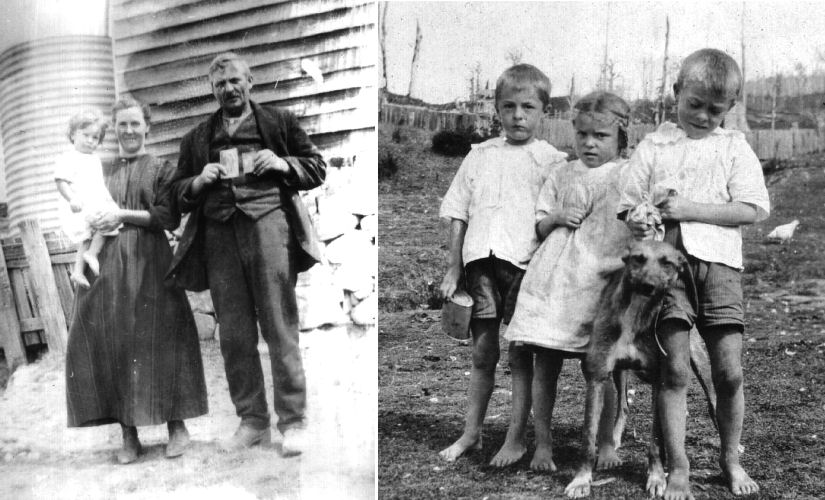
(Left) Lillias (babe in arms) and Mary Martin with Bert Martin, perhaps Tasmania’s longest-serving cave guide. (Right) The Martin twins of 1915 were followed by the Martin triplets in 1917. Raymond George, Rita Jean and Reginald Albert (pictured), were an incidental feature of a trip to Baldocks Cave.36 Photos courtesy of Ivy Crowden
Rustic charm and family fare: Baldocks Cave
There were no homestays at the Martin farm. The government-owned Baldocks Cave, however, provides another example of a backblocks farming family—in this case an immense family, at least 12 children being born in the years 1909 to 1925— building a cave tourism business at home. From 1903 the lessee of Baldocks was Albert Herbert Peter Hissell (Bert) Martin, beginning a tenancy of perhaps more than 40 years. This makes him a contender for the title of Tasmania’s longest-serving cave guide. His caving feats fitted the bill of heroic explorer. The government-owned cave was lit by acetylene in 1909, and a ‘rustic tea house’ was constructed at the cave entrance.37 This building probably perished in 1915, when the Martins lost all but the clothes on their back to the same bushfire which prompted the closure of the Scotts Cave guesthouse.38 Having survived ‘my worst day on earth’, Bert and Mary rebuilt their uninsured home, dairy farm and business for the motor touring era:
When you reach a sign-post which reads: ‘Guide’s House,’ and points up the hillside, you frantically toot the horn of the car; loudly shout and call, and make every ear-splitting noise you can think of!
If that does not attract his attention, you get out of the car—and muttering darkly to yourself—toil up that hillside to the little home perched above.
Then out he comes, apologising all the time and laughing heartily, and leads the way down the hill at a double-quick pace, shouting to his young son to ‘hurry-up-there-now-come-along-do!’ 39
Bert Martin was not averse to borrowing a little magic from the rival Marakoopa Cave by claiming that Baldocks was the setting for Marie Bjelke Petersen’s romance novel The Captive Singer. To demonstrate the plight of the book’s heroine, Iris Dearn, Martin extinguished the light—a staple of cave tours worldwide to this day.40 Magnesium ribbon was burnt to highlight particular features to which the acetylene jets did not do justice.41 The trailing son referred to above was probably Ernie, who often joined his father in the cave, training, like his sister Thelma, to become a Baldocks guide himself.42

(Left) Lucy King sliding through the ‘Dry Swim’ entrance to the second chamber of Baldocks Cave. Her clutching of a candle suggests this photo may pre-date the installation of the Baldocks acetylene system in 1909. (Right) Morning tea at noon, lunch at 1.30PM, allowing 90 minutes for Baldocks Cave guide Bert Martin to weave his magic. HJ King photo courtesy of the late Daisy Glennie; advert from a tourism guide
Although the difficult ‘Dry Swim’ section at Baldocks was cut away during the early 1920s, failure to secure the electric light doomed the cave to a dwindling custom after 1928.43 Two surviving visitors’ books suggest that in the years 1923–29 it received at least 4,500 customers. Praise for the cave (including descriptions such as ‘Bonza’, ‘Tres Bon’, ‘Top Hole’, ‘Snifter’, ‘Splendid’ and ‘Snodger’) and the guide, usually Bert Martin (‘Chaplin’s Double’, ‘very fine chap’ and ‘better than Mark Twain’) abound in these books, as do compliments about Mary Martin’s hospitality and home-style teas and dinners (featuring cream, cream cakes, raspberries, raspberry jam, tarts, homemade bread and mushrooms).44
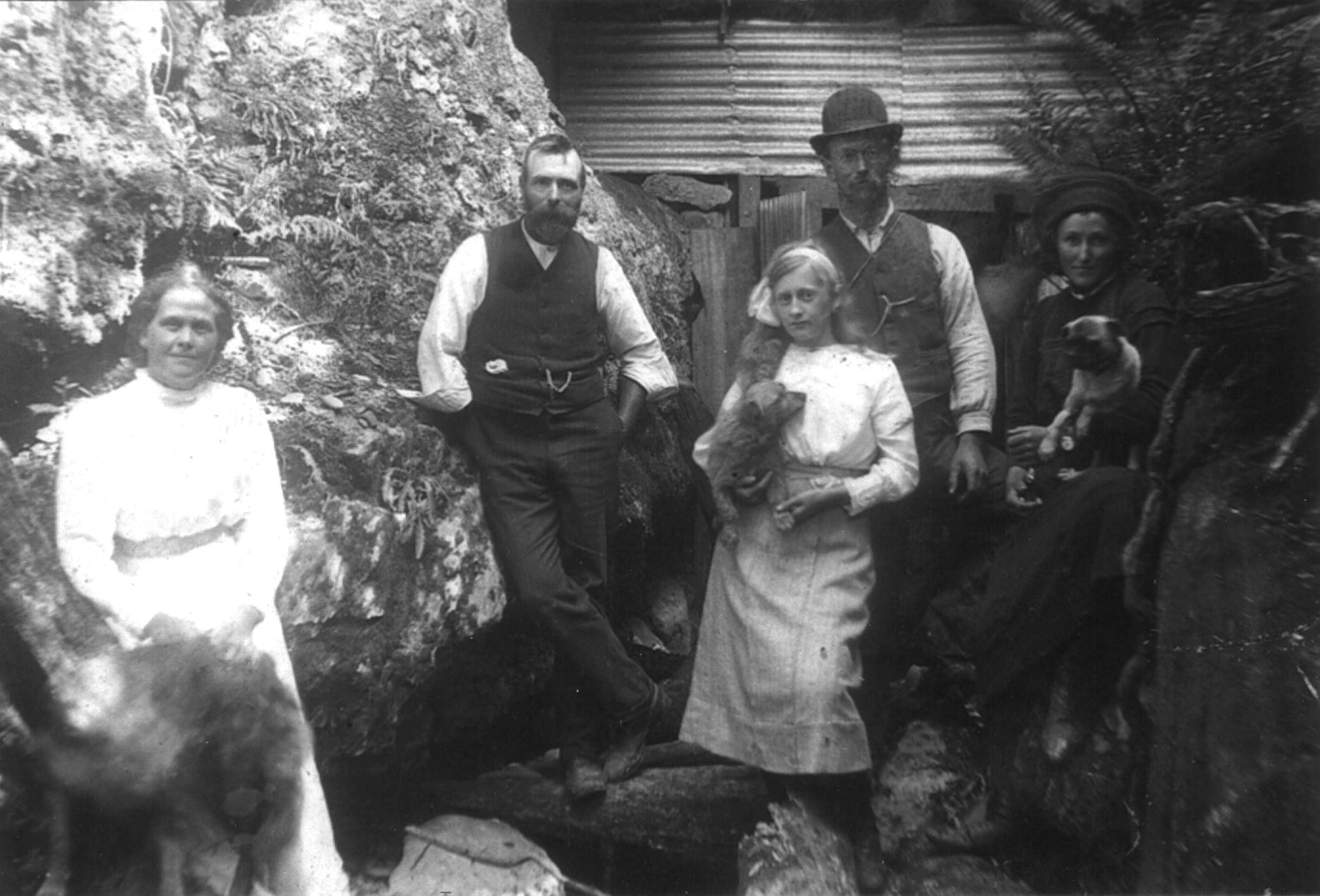
Members of the Byard family outside the entrance of Marakoopa Cave. Discoverers Jim and Harry (in hat) are at the back. The girl in front of Harry is probably their sister Jane, who also sang and guided in the cave, and the woman at left is probably their mother, Jane, caterer and, presumably, crèche matron. Courtesy of Paul van Nynanten
From cottage to cathedral: songs of praise for Marakoopa Cave
Having their own cathedral must have been very appealing to the Byards. Strict Baptists and dairy farmers Jabez and Jane Byard took the name of their house, ‘Berachah’, from a town between Hebron and Jerusalem in Israel, the scene of an Old Testament battle.45 ‘Berachah’ roughly translates as ‘Valley of the Blessings’, and blessed were the Byards in about 1905 when along the valley Jim Byard, then in his early 20’s, and brother Harry, 11 years his junior, explored a sometimes subterranean creek. It emerged from a cleft in a rock face. ‘We’ll keep this up our sleeves’, Jim told Harry after their second visit to the labyrinthine chambers of what they later called Marakoopa Cave.46
Jim bought the adjoining Crown land which contained the cave mouth, and from 1911 Marakoopa operated as a family business. The financial limitations of this, obvious today, probably escaped the censure of first-time show cave visitors. Guard rails and ladders guided travel, but there were no walkways, patrons sometimes having to clamber over flowstone. The cave was lit by hand-held acetylene bicycle lamps and later by miners’ lamps. Unlike Scotts or King Solomons, Marakoopa was a massive cave, making it far too expensive to install an acetylene lighting system. Guides supplemented their hand-held lamps by burning magnesium wires at every notable feature, conferring on them a ‘weird beauty’. Still, the cave was never effectively lit during the Byard era.47

Marakoopa is an acoustic paradise. The Byards played ‘Davids Harp’ with a mallet during cave tours. Today it receives ‘hands off’ treatment as a living example of the immensely slow process of calcite column formation. Stephen Spurling III photo courtesy of the National Library
The lamps became very hot, sometimes burning those who came into contact with them.48 One visitor forgave the ‘loss of dignity in crawling’, another wetness ‘underfoot’.49 ‘The rippingest sight out of England’, a Mother-countryman enthused.50 Small children who might have been admitted to Scotts Cave were checked in at the Marakoopa crèche instead, probably because the three-kilometre-long walk to the cave from the Byard family homestead was too taxing, the hand-held acetylene lamps too dangerous, but also, possibly, out of fear of losing the innocents in the cave labyrinth.51
As Scotts Cave was cosy enough for a gnome empire, Marakoopa was big enough for God’s. ‘Berachah’ was a rabbit warren compared to the cave’s ‘Great Cathedral’. No wonder the Byards, cramped up in their farmhouse, liberated their voices in this vast chamber, exploring its full resonance:
The guide, in a low voice, asked ‘Do you sing at all?’ …He walked away several paces, and then in this awe-inspiring cathedral, in the bowels of the earth, he sang Rida Johnson Young’s lyric ‘Mother Mackree’. I stood dumbfounded. He had a good voice, and away in the depths it was followed with echoes that seemed to run for miles. It was here, there, and everywhere…his voice seemed to travel like wings away and away through caverns and chambers for leagues…52
In 1914 Hobart romance novelist Marie Bjelke Petersen and her companion Sylvia Mills joined a Marakoopa tour party. Like the Byards, Bjelke Petersen was a pious, tee-totalling Christian. The Byards’ vocal performance and the shadow and light effects created by the acetylene lamps in the massive, dark cave must have worked on the author’s imagination, because her romance novel The Captive Singer was clearly derived from the experience.
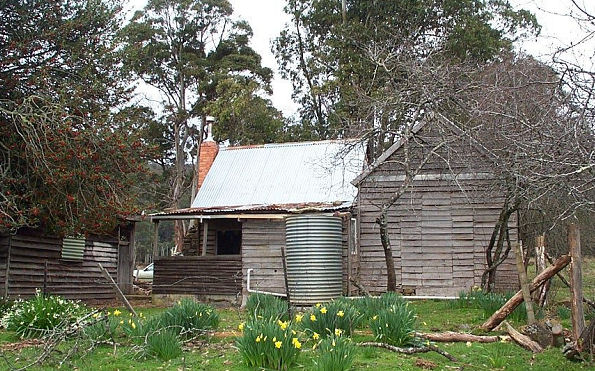
The Byard farmhouse ‘Berachah’— or ‘Possum Palace’— today. At least two Byard family weddings were celebrated here. Light refreshments and a crèche service for patrons’ children were provided during Marakoopa tours. Photo by Paul Van Nynanten
Corporatising the cottage: the government takes control
By the 1920s, mainlanders accustomed to electric cave lighting disparaged Tasmania’s comparatively weak acetylene gas. Entrance requirements of physical agility at Scotts Cave, a head for heights in King Solomons Cave and ability to turn turtle at Baldocks Cave must have limited these caves’ custom.53 The financial stringency of small family businesses was obvious.
The death of private cave tourism was encouraged by a 1918 report on the management of Tasmania’s caves by Voss Wiburd. The report is notable for its hysteria. He believed Scotts Cave too dangerous to be open to the public. In fact he used Scotts as an excuse to damn private cave tourism altogether, suggesting that purchases or leases of Crown land be issued with the specification that limestone features on the land remained public property. Wiburd’s complaint about Scotts presumably related partly to its rickety cliff-face balcony and awkward entrance, but he also loathed and feared acetylene gas lighting systems. While the safeness of acetylene had been widely debated at its introduction in the 1890s, by now it was commonly used in underground mines, public halls, hotels, private homes, and for street and vehicular lighting. There were regular press reports of acetylene explosions, but only one death by this means had been reported in Tasmania by 1918 and not a single incident was ever reported in any Tasmanian cave lit by acetylene.54 For Wiburd, however, the installation of acetylene lighting was ‘a great mistake’:
The pipes running through beautiful grottoes over head [sic] and under foot, along passages, with props and stays, bends, and reflectors does not improve or add to the beauty of a cave but seems to mar the view, offend the ear by its fizzing, and fumes are very disagreeable to smell and would in many cases overcome a weak or delicate person. In our caves we will not allow an aceteline [sic] lamp to be carried. We know what happens if anything goes wrong with it. Candles are much safer and can be depended on.
Not even Marie Bjelke Petersen’s delicate flower of a heroine in The Captive Singer, Iris Dearn, had succumbed to acetylene fumes! Still, Marakoopa and King Solomons, according to Wiburd, needed to be government owned, lit by electricity and safeguarded by iron gates and caretakers. At the time of Wiburd’s report, his only son was serving at the front, so it is not surprising to see the Jenolan expert expressing the hysterical anti-German sentiment generated in Australia during World War I. He warned Emmett to guard Tasmania’s caves against ‘Vandals, Huns and travelling lunatics’.55
Wiburd’s recommendations were blessed by a Caves Advisory Board appointed by cabinet. King Solomons (1920) and Marakoopa (1921) joined Baldocks as state possessions.56 This meant that, aside from the sporadically-visited Flowery Gully Cave, Scotts Cave was the only Tasmanian tourist cave left in private hands.57
While the full glories of King Solomons and Marakoopa were finally seen under electric light, the tradition of serving refreshments and lunches faltered under government control. In the private cave era, most of the simple fare served had been fresh homegrown produce. Visitor numbers were small, costs minimal, with no administrative overheads or red tape.
It was a different story when government-operated caves got down to business in the post-World War II period. Although tearooms and restaurants attached to King Solomons, Newdegate and Marakoopa Caves were operated as private enterprises, they were a constant headache to both the Tourist Department as well as their operators.58 Patrons grumbled when food and drink were unavailable. Guides’ catering wives were run ragged providing these. Caterers were not employed (that is, not paid) by the government, yet the Tourist Department required them to provide teas and meals whenever patrons requested them, even on Christmas Day. Refusal to cater was viewed as a breach of the conditions under which the married couple was engaged, making the female partner effectively a round-the-clock slave.59 If some of the simple pleasures of the cave visit were lost by the new business model, however, the gains were more substantial: safer, less damaged, better lit caves educating a wonderstruck public.
References
- These figures are derived from a table in Statistics of Tasmania 1917, p.246, which quotes stock numbers as at 1 March 1918. Figures for the districts of Evandale, Fingal and Launceston have been removed from the statistical division of north-east, and Westbury has been removed from the north-west division. These districts have been more appropriately included in the Midlands division.
- Sharon Morgan, Land Settlement in Early Tasmania: Creating an Antipodean England, Cambridge University Press, Oakleigh, Victoria, 1992, p.22.
- Statistics of Tasmania 1922–23, p.58; transcript of a 1972 interview with Anderson (‘Jack’) Scott (held by Jim Scott, Hobart).
- See Nic Haygarth, ‘Dan Pickett, Pioneer Cave Guide’, paper in these proceedings.
- See Marian Walker, Memories, Dreams and Inventions: the Evolution of Tasmania’s Tourist Image 1803–1939, PhD thesis, University of Tasmania, 2008, pp.192–99.
- ‘Peregrinator’ (WD Weston), ‘Notes of a Trip in the Vicinity of the Cradle Mountain’, Colonist 17 March 1888, p. 4; John Wat Tyler to Henry Dobson 11 May 1893, PD1, vol.60 103/93 (Tasmanian Archive and Heritage Office).
- See Nic Haygarth, ‘Ozone-wetted Appetites and Hearts Devoid of Care: Cruising to Cave-land in Nineteenth-century Tasmania’, Proceedings of the Cave and Karst Management in Australasia 17 Conference, Buchan, 2007, ACKMA, 2007, unpaginated DVD.
- See Nic Haygarth, ‘Theophilus Jones: Tasmania Through Anglo-Indian Eyes in the 1880s and 1890s’, Proceedings of the Launceston Historical Symposium 2011, forthcoming publication.
- See, for example, ‘The Chudleigh Caves’, Examiner 22 January 1901, p.5; and ‘A Visitor’, ‘Westmoreland Falls’, Examiner 7 December 1894, p.7.
- See, for instance, ‘Quinnat’, ‘Chudleigh Lakes: no.1’, Weekly Courier 10 March 1902; ‘Trip to Chudleigh Caves’, Launceston Examiner 11 January 1900, p.5; and ‘A Trip to the Caves’, Launceston Examiner 28 January 1902, p.3.
- For the ‘Yosemite Valley of Tasmania’, see ‘One of the Party’, ‘A Trip to Lake McKenzie and the Devil’s [sic] Gullet’, Examiner 24 December 1896, p.10. For general discussion about the Shannon Rise, see Simon Harris, Selling Tasmania: Boosterism and the Creation of the Tourist State 1912–1928, PhD thesis, University of Tasmania, 1993.
- Kate Weindorfer died in 1916, after which her husband Gustav Weindorfer continued to operate Waldheim Chalet until his death in 1932.
- See Jim Scott, Down the Crick: Stories of Early Generations of Scotts at Mole Creek, the author, Hobart, 1996.
- Transcript of a 1972 interview with Anderson (‘Jack’) Scott (held by Jim Scott, Hobart).
- For Hartnett, see Simon Cubit and Nic Haygarth, ‘Paddy Hartnett: Tasmanian Frontiersman’, Papers and Proceedings of the Tasmanian Historical Research Association, vol.57, no.2, August 2010, pp.80–104. For Weindorfer, see GFJ Bergman, Gustav Weindorfer of Cradle Mountain, Tasmanian Government, Hobart, 1959.
- Jim Scott, Down the Crick…, p.29.
- Miss IA Greenhill, Mr Thos HW Jones et al 19 January 1922, p.192, Scott’s Cave visitors’ book 1911–29, NS1780/1 (Tasmanian Archive and Heritage Office).
- 9 March 1912, p.30, Scotts Cave visitors’ book 1911–29.
- ‘One of the Five’, ‘In the Fertile North West’, Examiner 14 February 1911, p.3.
- Transcript of a 1972 interview with Anderson (‘Jack’) Scott (held by Jim Scott, Hobart).
- Jim Scott, Down the Crick: Stories of Early Generations of Scotts at Mole Creek, pp.40–41.
- Elphinstones: Pioneer Farmers in Tasmania, no publication details, 1988, p.85.
- EC James to Colin Pitt, Scenery Preservation Board 12 February 1942, AA577/1/6 (Tasmanian Archive and Heritage Office).
- Interview with Bill James June 2011.
- King Solomons Cave was reputedly discovered by WH Pochin and either Ern or Alf Holmes when their dog chased a wounded wallaby among some limestone rocks—where it vanished into a typical ‘animal trap’, the original cave entrance which can still be seen today near the old generator shed. Other writers claim the men were following a swarm of bees. For various discovery stories, see ‘A New Caveland: King Solomon’s [sic] Caves at Mole Creek’, Examiner 14 September 1908, p.6; FAW Gisborne, ‘Underground Tasmania’, The Red Funnel vol.IX, no.1, August 1909, p.3; ‘King Solomon’s [sic] Caves’, Examiner 2 November 1911, p.6; or ‘The Land of Caves and Caverns’, Advocate 19 December 1928, p.7.
- See file TRE 5/1/1075 no.2254/16 (Tasmanian Archive and Heritage Office).
- EC James, ‘King Solomons Caves’, Examiner 19 November 1908, p.7.
- James probably recalled the islands named Hope, Faith and Charity in Port Esperance at Dover, his home town. Port Esperance also featured a King Solomons Beach (‘Picturesque Port Esperance’, Mercury 5 March 1930, p.8).
- Wiburd stated that King Solomons was the finest cave in Tasmania (‘King Solomons Caves’, Mercury 30 January 1915, p.7). James claimed that Wiburd stated King Solomons was the finest cave in Australia (EC James, ‘Mole Creek Caves’, Mercury 29 April 1918, p.2).
- For the bowling trophy, see ‘Bowling’, Mercury 4 January 1909, p.7. For conducting the first government tour to Mole Creek, see ‘Mole Creek Caves’, Examiner 23 April 1915, p.3. For the electioneering, see advert, Mercury 29 June 1917, p.6.
- EC James to ET Emmett 9 November 1939, AA494/68 227/1/38, ‘King Solomons Cave’ (Tasmanian Archive and Heritage Office).
- See Sydney (Bill) James, The Blazed Track, the author, Launceston, 1996, p.25.
- The conveyance (Memorial no 12/212) was not registered until 31 March 1909 (Land Titles Office, Department of Primary Industries, Parks, Water and Environment, Hobart).
- ‘Deloraine Licensing District’, Examiner 8 April 1909, p.8.
- ‘Mole Creek’, Examiner 22 December 1928, p.9.
- Birth records 1469/1917, 1470/1917 and 3475/1917 respectively (Tasmanian Federation Index database). A birth notice gives the boys’ names as Reginald Ernest and Ronald Ernest (‘Births’, Examiner 17 November 1917, p.1).
- ‘Tourist Association: Meeting of Committee’, Daily Telegraph 9 March 1909, p.8.
- ‘Great Bush Fires’, Examiner 18 February 1915, p.6.
- ‘Grapho’, ‘In the Mist of the Mountains: the Magic of Mole Creek’, Advocate 17 January 1925, p.1.
- ‘Grapho’, ‘In the Mist of the Mountains…’.
- ‘IHC’, ‘The Playground of Australia’, Advocate 14 May 1924, p.11.
- See Hilton Stott’s Wesley Dale website stott.customer.netspace.net.au/Wesley.htm.
- ‘Mole Creek Caves’, Examiner 3 September 1920, p.7.
- The Baldocks’ visitors’ books are held by Ivy Crowden, George Town.
- See Book of Corinthians 2, 20:24–31.
- ‘Hole in the Ground Led to Marakoopa Wonderland’, Advocate 30 March 1968.
- ‘Verdant’, ‘A Visit to the Wonderland of Tasmania’, Weekly Courier 29 February 1912, p.29.
- ‘History of World-Famous Marakoopa Caves’, Advocate 12 February 1960, p.18.
- Mary C Dickson 23 February 1915; ? Webb 27 February 1916, Marakoopa visitors’ book (held by Mrs Kelly, South Mole Creek).
- I Wallis 18 January 1912, Marakoopa Cave visitors’ book.
- ‘Verdant’, ‘A Visit to the Wonderland of Tasmania’, p.28.
- ‘The Maracoopa [sic] Caves’, Mercury 23 March 1928, p.7.
- See Charles Miscamble, Commissioner of Railways, to Minister for Railways 15 August 1927, AB455/4 R21/1 (Tasmanian Archive and Heritage Office).
- For the death of Launceston photographer Albert Sargent, see ‘Acetylene Gas Explosion’, Mercury 28 August 1913, p.5.
- Voss Wiburd to ET Emmett 7 January 1918, ‘Tasmanian Caves 1921–28’, TC10/1/1882 21/285 (Tasmanian Archive and Heritage Office).
- Wiburd had recommended the government buy King Solomons after his first visit in 1909. For the Caves Advisory Board, see ‘The Caves’, Daily Telegraph 2 February 1920. Under the Public Works Execution Act (1915), £900 were set aside for the government acquisition of King Solomons (see file TRE 5/1/1075 no.2254/16 [Tasmanian Archive and Heritage Office], which also discusses arrangements for WH Pochin to receive some of this money).
- Scenery Preservation Board minute book 18 September 1918, AA264/1/1 (Tasmanian Archive and Heritage Office).
- See, for instance, Torry Richardson’s report 22 January 1961, AA494/141 703/1/59 ‘Mole Creek Inspections’ (Tasmanian Archive and Heritage Office).
- See FH Southey to Roy Skinner 13 January 1960; and Roy Skinner to FH Southey 14 January 1960, AA494/1/336 176/6/59 (Tasmanian Archive and Heritage Office).